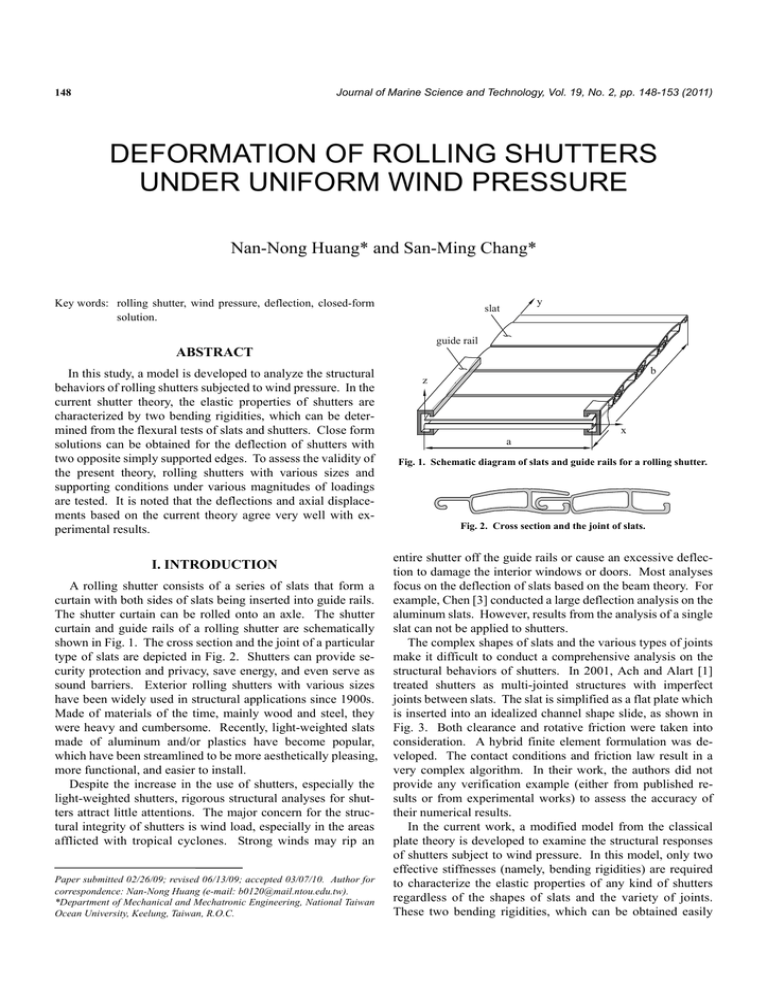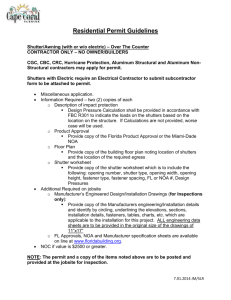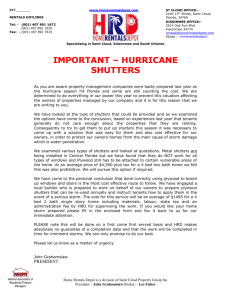deformation of rolling shutters under uniform wind pressure
advertisement

Journal of Marine Science and Technology, Vol. 19, No. 2, pp. 148-153 (2011) 148 DEFORMATION OF ROLLING SHUTTERS UNDER UNIFORM WIND PRESSURE Nan-Nong Huang* and San-Ming Chang* Key words: rolling shutter, wind pressure, deflection, closed-form solution. guide rail ABSTRACT In this study, a model is developed to analyze the structural behaviors of rolling shutters subjected to wind pressure. In the current shutter theory, the elastic properties of shutters are characterized by two bending rigidities, which can be determined from the flexural tests of slats and shutters. Close form solutions can be obtained for the deflection of shutters with two opposite simply supported edges. To assess the validity of the present theory, rolling shutters with various sizes and supporting conditions under various magnitudes of loadings are tested. It is noted that the deflections and axial displacements based on the current theory agree very well with experimental results. I. INTRODUCTION A rolling shutter consists of a series of slats that form a curtain with both sides of slats being inserted into guide rails. The shutter curtain can be rolled onto an axle. The shutter curtain and guide rails of a rolling shutter are schematically shown in Fig. 1. The cross section and the joint of a particular type of slats are depicted in Fig. 2. Shutters can provide security protection and privacy, save energy, and even serve as sound barriers. Exterior rolling shutters with various sizes have been widely used in structural applications since 1900s. Made of materials of the time, mainly wood and steel, they were heavy and cumbersome. Recently, light-weighted slats made of aluminum and/or plastics have become popular, which have been streamlined to be more aesthetically pleasing, more functional, and easier to install. Despite the increase in the use of shutters, especially the light-weighted shutters, rigorous structural analyses for shutters attract little attentions. The major concern for the structural integrity of shutters is wind load, especially in the areas afflicted with tropical cyclones. Strong winds may rip an Paper submitted 02/26/09; revised 06/13/09; accepted 03/07/10. Author for correspondence: Nan-Nong Huang (e-mail: b0120@mail.ntou.edu.tw). *Department of Mechanical and Mechatronic Engineering, National Taiwan Ocean University, Keelung, Taiwan, R.O.C. y slat b z x a Fig. 1. Schematic diagram of slats and guide rails for a rolling shutter. Fig. 2. Cross section and the joint of slats. entire shutter off the guide rails or cause an excessive deflection to damage the interior windows or doors. Most analyses focus on the deflection of slats based on the beam theory. For example, Chen [3] conducted a large deflection analysis on the aluminum slats. However, results from the analysis of a single slat can not be applied to shutters. The complex shapes of slats and the various types of joints make it difficult to conduct a comprehensive analysis on the structural behaviors of shutters. In 2001, Ach and Alart [1] treated shutters as multi-jointed structures with imperfect joints between slats. The slat is simplified as a flat plate which is inserted into an idealized channel shape slide, as shown in Fig. 3. Both clearance and rotative friction were taken into consideration. A hybrid finite element formulation was developed. The contact conditions and friction law result in a very complex algorithm. In their work, the authors did not provide any verification example (either from published results or from experimental works) to assess the accuracy of their numerical results. In the current work, a modified model from the classical plate theory is developed to examine the structural responses of shutters subject to wind pressure. In this model, only two effective stiffnesses (namely, bending rigidities) are required to characterize the elastic properties of any kind of shutters regardless of the shapes of slats and the variety of joints. These two bending rigidities, which can be obtained easily N.-N. Huang and S.-M. Chang: Deformation of Rolling Shutters Under Uniform Wind Pressure Qy slat Mxy Nx Mxy z clearance y imperfect joint x Fig.3. The slats and the joint of shutters studied by Ach and Alart [1]. from the flexural tests of slats and shutter curtains, presumably can account for the effects of clearance and friction of the joints. Close form solutions based on Levy’s method can be obtained for the shutters with two opposite simply supported edges. Deformation tests are conducted for the shutters with various dimensions and different types of supports under various magnitudes of loading. The deflections and axial displacements are measured. Results based on the current model agree very well with the experimental results. Mx Nx Mx Qx Myx Qy Fig. 4. Resultant forces on an infinitesimal shutter element. Myx + dMyx Qy + dQy Mx + dMx p Qx Mxy Qx + dQx Mx Mxy + dMxy dy z dx Qy y Myx x Fig. 5. Forces exerting on a differential shutter element. II. THEORY The coordinate system for the shutter analysis is shown in Fig. 1. Coordinate x is in the longitudinal direction of the slat, y is in the rolling direction, and z is in the transverse direction of the shutter. The length of the shutter in the x and y directions are a and b, respectively. A modified theory based on the classical plate theory is introduced hereafter. The joints of slats, as indicated in Fig. 2, serve as flexible linkages so that slats are able to revolve around the reel of shutter. In this respect, a shutter is free to stretch and roll up in the y direction and provides no in-plane shear rigidity. Therefore, stress resultants Ny, Nxy, Nyx, and My are assumed to be negligible. The nonzero stress resultants are depicted on an infinitesimal shutter element as shown in Fig. 4. For the case of small displacement gradient problems, the in-plane responses are decoupled from the out-of-plane responses. Hereafter, only out-of-plane behaviors of shutters are concerned. The moments are related to curvatures and bending rigidities by [6] (1) Following the Kirchhoff constraint, the curvatures are related to the deflection by κ x = − w, xx , κ y = − w, yy , κ xy = −2w, xy Myx Qx slat M x = Dxκ x , M xy = Dxyκ xy , M yx = Dyxκ xy 149 (2) Consider a differential shutter element subject to transversely distributed loading p(x, y) as shown in Fig. 5. The stress resultants acting on the element are also indicated in the figure. The moment equilibrium conditions in the x and y directions are Qy = M xy , x , Qx = M x , x + M yx , y (3) Equating the forces in the z direction yields Qx , x + Qy , y + p = 0 (4) Substituting Eqs. (1)-(3) into the above equation gives Dx w, xxxx + 2( Dxy + Dyx ) w, xxyy = p (5) Upon introducing the following non-dimensionalized parameters W= d= w , a X= x y , Y= a b 2( Dxy + Dyx ) Dx , p= pa 3 a , λ= Dx b (6) force equilibrium Eq. (5) can be rewritten as W, XXXX + λ 2 d W, XXYY = p (7) III. LEVY SOLUTION AND AXIAL DISPLACEMENT The shutter curtain is assumed to be simply supported by guide rails. For shutters with two opposite simply supported edges, the close form solutions to Eq. (7) are available. Con- Journal of Marine Science and Technology, Vol. 19, No. 2 (2011) 150 sider edges x = 0 and a (X = 0, 1) are simply supported. Following the Levy approach [6], the deflection and loading are represented by the Fourier sine series: [W ( X , Y ), p( X , Y )] = ∑ sin(iπ X ) ⎣⎡Wi (Y ), pi (Y )⎦⎤ l z ds dw s (8) w i =1 It is noted that the assumed deflection satisfies the following simply supported conditions on edges X = 0, 1: deformed config. x dx original config. a Fig. 6. Deflection curve and axial displacement (Δ = l – a) of a shutter. W (0, Y ) = W (1, Y ) = M x (0, Y ) = M x (1, Y ) = 0 (9) The wind pressure distribution on a wall, which is at right angle to the wind direction, was reported by Dalgliesh and Schriever [4]. The maximum wind pressure (i.e., stagnation pressure) develops near the center of the wall. The pressure contours reveal that there is an increasingly steep pressure gradient towards the edges of the wall [4]. For the purpose of shutter design, the wind pressure is assumed to be uniform over the entire shutter curtain. The Fourier coefficients for uniform loading, p ( X , Y ) = q , are l ( y) = ∫ a ds dx = ∫ 0 dx a 0 1 + ( w, x ) 2 dx (14) Introducing L = l/a yields the non-dimensionalized expression for the above equation: L(Y ) = ∫ 1 1 + (W, X ) 2 dX 0 (15) The axial displacement for the slat can then be determined as ⎧4q /(iπ ) (i = 1,3,5,…) pi (Y ) = ⎨ (i = 2, 4,6,…) ⎩ 0 (10) By substituting Eqs. (8) and (10) into Eq. (7), the partial differential equation is reduced to the following set of ordinary differential equations: Wi′′ − βi2 Wi = − fi (11) (iπ ) 2 , λ 2d (12) in which β i2 = fi = pi (iπ ) 2 λ 2 d The general solution to Eq. (11) is Wi (Y ) = c1i cosh( β iY ) + c2i sinh( βiY ) + fi / βi 2 1 Δ( y ) = l − a = a ⎡ ∫ 1 + (W, X ) 2 dX − 1⎤ ⎢⎣ 0 ⎥⎦ The Simpson rule is employed in this study to evaluate the above integral. The particular solutions corresponding to two boundary value problems are presented hereafter. First, consider a shutter with all edges simply supported (designated as SSSS). The second problem corresponds to a shutter having three simplysupported edges and one free edge (designated as SSSF). 1. SSSS Shutters The coordinates for an SSSS shutter are shown in Fig. 7(a). The simply supported condition along edges Y = ±1/2 is W(X, ±1/2) = 0, which leads to Wi (±1/ 2) = 0 (13) where c1i and c2i are arbitrary constants. In addition to the knowledge of deflection, the calculation of axial displacements of slats is also very important for the design of shutters. A slat with an excessive axial displacement could rip off guide rails. For an inextensible slat, the axial displacement can be determined from the length of the deflection curve between supports. Consider the deflection curve of a shutter in the x direction (i.e., the longitudinal direction of slats) as shown in Fig. 6. Let s be the coordinate along the deflection curve. The length of the deflection curve between supports is (16) (17) Coefficients c1i and c2i in Eq. (13) can be determined from the above condition and by considering the symmetry of the structural responses with respect to X axis: c1i = − fi βi 2 cosh( βi / 2) , c2i = 0 (18) Therefore, the deflection solution of the SSSS shutter is W ( X ,Y ) = ∑ fi 2 i =1,3,5,… β i ⎡ cosh( βiY ) ⎤ sin(iπ X ) ⎢1 − ⎥ βi / 2) ⎦ cosh( ⎣ (19) N.-N. Huang and S.-M. Chang: Deformation of Rolling Shutters Under Uniform Wind Pressure Y Y S 1/2 1 slats S 1 S 151 X S S S X -1/2 S F 1 (b) (a) Fig.7. Coordinates for (a) SSSS shutter and (b) SSSF shutter. 2. SSSF Shutters The coordinates for an SSSF shutter are shown in Fig. 7(b). The simply supported condition along edge Y = 1 is W(X, 1) = 0, which leads to Wi (1) = 0 support Fig. 8. Schematic diagram of the setup for shutter tests. (20) Along the free edge Y = 0, the boundary condition is Qy + Myx,x = 0 [5]. By introducing moment equilibrium condition Eq. (3), the boundary condition becomes M xy , x + M yx , x = 0 (21) Substituting moment-curvature relations Eq. (1) into the above equation yields κxy, y = 0, which subsequently results in W, XYY (X, 0) = 0. Therefore, the boundary condition along Y = 0 is Wi′ (0) = 0 (22) Undetermined coefficients c1i and c2i in Eq. (13) can be obtained by satisfying both boundary conditions Eqs. (20) and (22): c1i = − fi βi 2 cosh( β i ) , c2i = 0 (23) Then the deflection solution of an SSSF shutter is W ( X ,Y ) = ∑ fi 2 i =1,3,5,… β i ⎡ cosh( β iY ) ⎤ sin(iπ X ) ⎢1 − ⎥ cosh( βi ) ⎦ ⎣ (24) IV. EXPERIMENTS AND RESULTS In the current theory, two bending rigidities Dx and d are required for the shutter analysis. First, rigidity Dx is determined from the cylindrical bending test of slats. For the slat considered in this study, a value of 137.2 Kg-m is adopted for Dx [3]. Then, the value of d can be determined from the bending test of a shutter assembly. Fig. 9. Deformation test of a shutter assembly loaded by uniformly distributed sand bags. To examine the validity of the current model, a series of tests on the rolling shutters with various sizes and supporting conditions are conducted. The SSSS shutters with following dimensions (a, b) are tested: (1.68 m, 1.14 m), (1.68 m, 1.52 m), (1.68 m, 1.90 m), (2.03 m, 1.14 m), and (2.03 m, 1.52 m). Meanwhile, the SSSF shutters with dimensions (a = 1.68 m, b = 1.14 m) and (a = 1.68 m, b = 1.52 m) are also tested. The setup of the shutter test is schematically shown in Fig. 8. The uniform loading is applied by using zip plastic bags filled with sand, which is illustrated in Fig. 9. The details of test procedures were described in Chang [2]. The shutters are subjected to various magnitudes of loadings. For most shutters tested, the maximum pressure is up to 200 Kg/m2, which is approximately equivalent to Force 16 in the Beaufort wind force scale. The maximum number of the Beaufort scale is Force 17. The deflections and axial displacements are measured using a dial gauge and a caliper, respectively. The test results for maximum deflection and axial displacement are plotted Journal of Marine Science and Technology, Vol. 19, No. 2 (2011) SSSF Shutters with a = 1.68 m b = 1.14 m 4m 40 b= 0 50 1.1 100 150 Pressure (Kg/m2) 200 8 Fig. 10. Comparison between the theoretical and experimental results of the central deflections and maximum axial displacements for the SSSS shutters with width a = 1.68 m and various heights (b = 1.14 m, 1.52 m, 1.90 m). SSSS Shutters with a = 2.03 m 32 1.5 2m 16 40 0 0 m 1.1 4 b= b= 1.5 80 50 100 150 Pressure (Kg/m2) 8 200 Maximum Axial Displacement (mm) 4m 1.1 b= 24 2m 120 deflection (theory) axial disp. (theory) deflection (exp.) axial disp. (exp.) b= Central Deflection (mm) 160 0 Fig. 11. Comparison between the theoretical and experimental results of the central deflections and maximum axial displacements for the SSSS shutters with width a = 2.03 m and various heights (b = 1.14 m, 1.52 m). against loadings in Figs. 10-12. Analytical results based on the current model are also included in the figures for comparison. Fig. 10 shows the responses of SSSS shutters with a = 1.68 m and b = 1.14 m, 1.52 m, and 1.90 m. The responses of SSSS shutters with a = 2.03 m and b = 1.14 m, 1.52 m are 1.5 2 m b = 1.14 m 80 16 40 0 0 0 24 m 16 b = 1.52 m 1.1 4 1.5 2m b = 1.52 m 120 32 deflection (theory) axial disp. (theory) deflection (exp.) axial disp. (exp.) b= b = 1.92 m 80 Central Deflection (mm) 24 Maximum Axial Displacement (mm) b = 1.90 m b= Central Deflection (mm) deflection (theory) axial disp. (theory) deflection (exp.) axial disp. (exp.) 120 0 160 32 8 50 100 150 Pressure (Kg/m2) 200 Maximum Axial Displacement (mm) SSSS Shutters with a = 1.68 m 160 b= 152 0 Fig. 12. Comparison between the theoretical and experimental results of the maximum deflections and maximum axial displacements for the SSSF shutters with width a = 1.68 m and various heights (b = 1.14 m , 1.52 m). given in Fig. 11. The responses of SSSF shutters with a = 1.68 m and b = 1.14 m, 1.52 m are shown in Fig. 12. For the SSSS shutters, the maximum deflection occurs at the center of curtain (i.e., central deflection) and the central slat possesses the maximum axial displacement. For the SSSF shutters, the maximum deflection is produced at the center of the free edge and the slat along the free edge has the maximum axial displacement. The experimental data for the central deflection of an SSSS shutter with a = 1.68 m and b = 1.52 m is employed to determine the value of bending rigidity d . The shutter assembly consists of 48 slats. The central deflection and maximum axial movement are shown in Fig. 10. It is noted that the deflection behavior is almost linear for a loading up to 500 Kg (196 Kg/m2 in pressure). The deflections and axial displacements calculated from the Levy solutions with d = 0.486 fit the test data very well. The effective stiffnesses Dx = 137.2 Kg-m and d = 0.486 are taken to be the elastic constants for shutters consisting of this particular type of slats. All the calculated results of shutters with various sizes and different types of supports are based on these two effective stiffnesses. The convergence rate of the close form solutions is very fast. For example, consider an SSSS shutter with a = 1.68 m and b = 1.52 m under a pressure of 156.6 Kg/m2. The numerical data of the central deflections and maximum axial displacements of the shutter, corresponding to various numbers of terms used in the series solution, are listed in Table 1. It is noted that even one-term solution produces near-converged results for both the deflection and axial displacement. The results presented in this paper are based on the 6-term series solutions. N.-N. Huang and S.-M. Chang: Deformation of Rolling Shutters Under Uniform Wind Pressure Table 1. Convergence rate of the Levy solution (SSSS shutter with a = 1.68 m and b = 1.52 m, under pressure 156.6 Kg/m2). Disp’ central deflection (mm) axial disp’ (mm) w(a/2, b/2) Δ(y = 0) # of terms 1-term (i = 1) 88.496 11.444 2-term (i = 1, 3) 88.008 11.446 3-term (i = 1, 3, 5) 88.046 11.446 4-term ((i = 1, 3, 5, 7) 5-term (i = 1, 3, …, 9) 88.039 11.446 88.041 11.446 6-term (i = 1, 3, …, 11) 88.040 11.446 7-term (i = 1, 3, …, 13) 88.040 11.446 A close examination of the results presented in Figs. 10-12 reveals that the theoretical results of deflections agree very well with the experimental data for all the shutters considered. A noticeable discrepancy in axial displacement exists in some shutters when the loading is small. However, the discrepancy between the theoretical values and test data diminishes as loading is increased. For the cases of small loadings, the axial displacement is trivial with a value of only a few millimeters, which makes it difficult to get an accurate measurement by using a caliper. Also, the difference may be partly due to the existence of friction between slats and guide rails, which could have a significant effect on the displacements in case of a small loading. Overall, the discrepancy in both deflections and axial displacements for all the shutters tested is less than 4% when pressure is higher than 100 Kg/m2. V. CONCLUDING REMARKS A model coupled with two bending rigidities is developed to predict the structural behaviors of shutters under wind pressure. The current theory, without the necessity of considering the details of the shapes of slats and the clearance of joints, can be viewed as a simplified model of the classical plate theory. The two effective stiffnesses can be determined from the bending tests of the slat and shutter. Close form solutions based on the current theory can be obtained for the shutters with two opposite simply supported edges. Deflections and axial displacements are calculated for the shutters with four simply supported edges and for the shutters with three simply supported edges and one free edge. To evaluate the limitations and accuracy of the current theory, bending tests are performed for the shutters with various dimensions and supporting conditions. The plastic sand bags are distributively stacked on the shutter to simulate the application of uniform wind pressure. The shutters are subjected to various magnitudes of pressure, with maximum pressure up to 200 Kg/m2 for most of the tests. Comparisons between theoretical predictions and experimental results are 153 made. It is noted that the discrepancy is small for both the deflection and axial displacement. For all the cases considered, the difference between theoretical and experimental results is less than 4% when loading pressure is higher than 100 Kg/m2. The light-weighted shutters are widely used in houses, shops and factories. However, due to the complexity of the shapes and the joints of slats, a simple but practical shutter theory has not been reported before. Most designs of shutters are based on past experience, which poses a great threat to public safety, especially in typhoon-afflicted areas like Taiwan. The present theory with its simplicity and accuracy can be adopted to make shutter design much easier and safer. NOMENCLATURE a, b c1i, c2i Dx, Dxy Dyx, d fi l(y), L(Y) Mx, My Mxy, Myx Nx, Ny Nxy, Nyx p, p, q pi (Y ) Q x, Q y s w, W Wi(Y) x, y, z X,Y βi Δ(y) κx, κy, κxy λ lengths of shutter coefficients in the solution to the differential Eq. bending rigidities bending rigidities parameter appearing in the differential Eq. (11) length of the deflection curve moments moments in-plane forces in-plane forces pressure Fourier coefficients for p ( X , Y ) shear forces coordinate along the deflection curve deflection Fourier coefficients for W(X,Y) coordinates non-dimensionalized coordinates parameter appearing in the differential Eq. (11) axial displacement of the slat curvatures geometric aspect ratio (a/b) REFERENCES 1. Ach, K. and Alart, P., “Numerical simulation of the behaviour of a multi-jointed structure,” Philosophical Transactions of the Royal Society of London A, Vol. 359, pp. 2557-2573 (2001). 2. Chang, S. M., Deformation of Aluminum Rolling Shutters under Wind Load, Master Thesis, Department of Mechanical and Mechatronic Engineering, National Taiwan Ocean University, Keelung, Taiwan (2002). 3. Chen, H. C., Deflection Behavior of Aluminum Rolling Shutter Leaves, Master Thesis, Department of Mechanical and Mechatronic Engineering, National Taiwan Ocean University, Keelung, Taiwan (2002). 4. Dalgliesh, W. A. and Schriever, W. R., “Wind pressures on buildings,” Canadian Building Digest, CBD34, NRC-IRC (1968). 5. Rivello, R. M., Theory and Analysis of Flight Structures, McGraw-Hill, New York (1970). 6. Timoshenko, S. P. and Woinowsky-Krieger, S., Theory of Plates and Shells, 2nd ed., McGraw-Hill, New York (1959).



